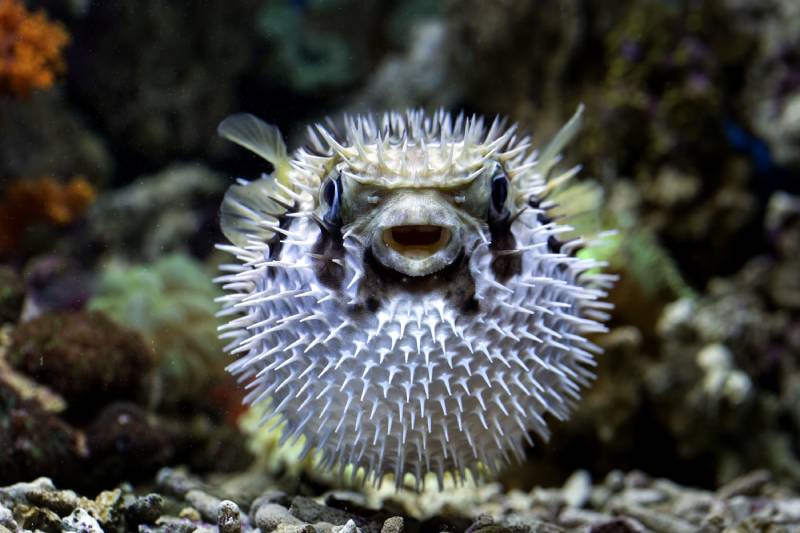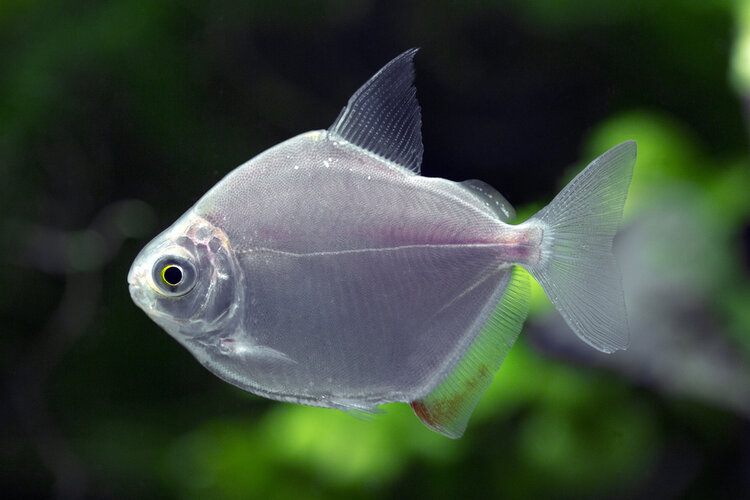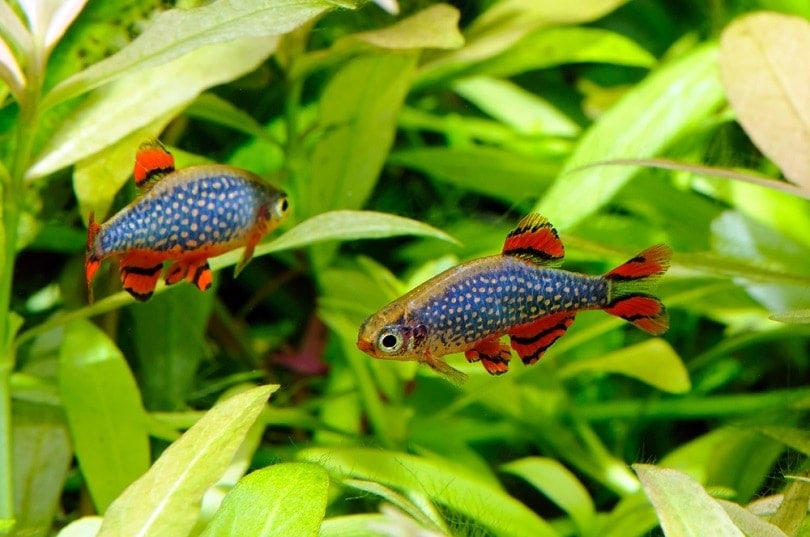8 Types of Saltwater Puffer Fish: Pictures, Facts & History
Updated on

Puffer fish are fascinating fish known for their ability to inflate themselves up to twice their original size when threatened. There are around 190 species of saltwater puffer fish belonging to the Tetraodontidae family and found worldwide.
They can be found in either freshwater, brackish, or saltwater habitats, although most species inhabit saltwater. Although there are plenty of saltwater puffer fish, only a select few are kept in captivity. These fish captivate hobbyists with their captivating behaviors, intelligence, and amusing defense mechanisms.
How Are Saltwater Puffer Fish Classified?
There are over a hundred species classified as saltwater puffer fish in the order Tetraodontiformes. Saltwater puffer fish can range in size and color, with some species growing up to 30 inches long. They are generally recognized by their elongated bodies, beaks, small fins, and striking colors or markings. Unlike most fish, puffer fish have spines rather than scales. This makes saltwater puffer fish more sensitive to water quality issues and a better choice for experienced fish keepers.
When feeling threatened, puffer fish will “puff up” their bodies to make them appear larger. Some species also have spines that stick out and make them unpalatable. The flesh and organs of puffer fish contain tetrodotoxin, which is dangerous when ingested.
The 8 Types of Saltwater Puffer Fish
Let’s take a look below at eight different types of saltwater puffer fish.
1. Sharpnose Valentini Puffer Fish

| Origin: | Indo-Pacific |
| Lifespan: | 10 to 15 years |
| Length: | 4 to 5 inches |
The Sharpnose valentini (Canthigaster valentini) is a small puffer fish also known as the Black Saddled Toby. They are native to the Indo-Pacific and found in subtropical or tropical marine water, like seaward reefs.
These puffers do not grow very large, and most adults only reach 4 inches long. You can recognize a Sharpnose valentini puffer by its large green eyes, yellow caudal (tail) fin, and cream body with black markings. They get their name from their elongated mouths and black markings that resemble a saddle.
Sharpnose valentini puffers are common in the aquarium trade where they make fascinating pets for skilled fish keepers. They require a minimum tank size of around 30 gallons and enjoy a diet containing various filamentous algae, corals, and mollusks. They do best in a species-only aquarium, and both males and females are territorial.
2. Blue-Spotted Puffer Fish

| Origin: | Central Pacific Ocean |
| Lifespan: | 10 to 15 years |
| Length: | 5 to 5 inches |
Blue-spotted puffers (Canthigaster solandri) are small fish found in the tropical Central Pacific waters. They are commonly called Sharpnose Spotted puffers and should not be confused with a similarly named species, Arothron caeruleopunctatus. Their natural habitat consists of rocky and seaward reefs at depths of 10 to 85 feet.
Blue-spotted puffers have brilliantly colored bodies, but their most distinctive feature is their neon blue spots and stripes. Most Blue-spotted puffers reach an adult length of 4.5 to 5 inches and do best in a spacious aquarium above 50 gallons. Fish keepers might want to think twice before placing them in aquariums with coral collections, as these puffers will eat them.
3. Stars and Stripes Puffer Fish

| Origin: | Indo-Pacific |
| Lifespan: | 8 to 15 years |
| Length: | 12 to 18 inches |
The Stars and Stripes puffer fish (Arothron hispidus) is one of the larger puffers kept in aquariums. They can reach up to 18 inches long, so a 180-gallon tank is the minimum size for these puffers. Stars and Stripes puffers have a predominantly white body paired with dark markings that create a dot-like outline.
Aside from being a prized puffer in captivity, they can be found in Indo-Pacific waters like reefs and tidepools. Once mature, Stars and Stripes puffer fish become solitary and semi-aggressive and should not be kept together. Like most puffers, they enjoy a varied diet of corals, krill, sponges, crabs, and algae.
4. Guineafowl Puffer Fish

| Origin: | Indo-Pacific, Eastern Pacific |
| Lifespan: | Up to 10 years |
| Length: | 20 inches |
The solitary Guineafowl puffer fish (Arothron meleagris) is found in the Indo-Pacific and Eastern Pacific waters. There they inhabit reefs and primarily feed on invertebrates like sponges and corals. Guineafowl puffers have an interesting appearance that resembles the African birds they are named after.
Their bodies are a dark greyish color with hundreds of tiny white dots. However, they can be found in different color forms—yellow, dark-spotted, and white. It is more common to see them with Guineafowl markings and the other variations are rare. You can find Guineafowl puffers in captivity where they make pricey marine pets or found displayed in professional aquariums.
5. Northern Puffer Fish

| Origin: | North America |
| Lifespan: | 10 to 15 years |
| Length: | Up to 14 inches |
The Northern puffer (Sphoeroides maculatus) is found at depths of 30 to 600 feet on the northwest Atlantic coast. These puffers are believed to contain less toxins in their flesh than other marine species, although some still have their doubts. Northern puffer fish have yellow bodies with a cream underside and dark brown bands across their dorsal area.
These puffer fish are eaten as a delicacy in sea squab dishes in the Cheapskate Bay area. Northern puffers enjoy a diet of shellfish such as crabs that they eat using their strong beaks.
6. Starry Puffer Fish

| Origin: | Indo-Pacific |
| Lifespan: | 10 to 15 years |
| Length: | Up to 47 inches |
Starry puffer fish (Arothron stellatus) boasts an impressive size of 3 feet long and can be found in the Indo-Pacific waters. Juvenile Starry puffers have a more yellow or orange body and larger brown markings than adults. The adults usually have a light grey color and small dark spots.
They are one of the largest puffer fish in the world and require exceptionally large aquariums to thrive. Therefore, this species is not recommended for beginner fish keepers and has demanding care requirements. In the wild, Starry puffer fish inhabit shallow reefs and lagoons at depths of 200 feet. They are eaten in Japan with the most toxic parts of their body removed, as their organs usually contain the highest concentrations of tetrodotoxin.
7. Dogface Puffer Fish

| Origin: | Indo-Pacific |
| Lifespan: | 10 to 20 years |
| Length: | 12 to 14 inches |
The Dogface or Blackspotted puffer (Arothron nigropunctatus) is one of the more scary-looking puffer fish on the list. They earn their name from their uncanny markings that resemble a dog’s face. They are found in numerous color variations, such as yellow, orange, grey, and light brown with dark markings around their mouth and eyes.
Adults can grow to a foot long and prefer a solitary lifestyle as nocturnal hunters. Dogface puffers are found in the tropical Indo-Pacific waters, aside from the Red Sea. They inhabit reefs and feed on benthic invertebrates.
This species is found in captivity and makes an interesting addition to spacious reef aquariums. Unfortunately, most captive specimens are wild-caught and have difficulty adjusting to life in aquariums. They may be difficult to feed at first and often refuse food.
8. Map Puffer Fish

| Origin: | Indo-Pacific |
| Lifespan: | 10 to 15 years |
| Length: | 18 to 26 inches |
The Map puffer fish (Arothron mappa) is a medium-sized species that inhabits tropical and subtropical waters in the Indo-Pacific region. Map puffer fish go by other common names like the Scribbled Toadfish or Arothron. These puffers have distinctive markings that make them a prized species to keep in aquariums. Their bodies are covered with gold, yellow, and cream markings with yellow-tinged fins.
Map puffer fish can grow very large at 26 inches long, so they should only be kept in tanks over 300 gallons. They are not compatible with reef aquariums because they will eat invertebrates, although they prefer meaty foods like squid and krill.
Featured Image Credit: Aries Sutanto, Shutterstock











